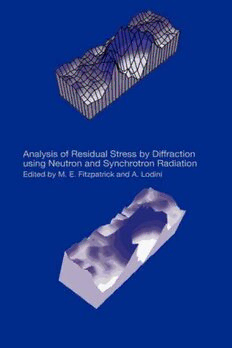
Analysis of Residual Stress by Diffraction using Neutron and Synchrotron Radiation PDF
367 Pages·2003·3.986 MB·English
Most books are stored in the elastic cloud where traffic is expensive. For this reason, we have a limit on daily download.
Preview Analysis of Residual Stress by Diffraction using Neutron and Synchrotron Radiation
Description:
While residual stress can be a problem in many industries and lead to early failure of component, it can also be introduced deliberately to improve lifetimes. Knowledge of the residual stress state in a component can be critical for quality control of surface engineering processes or vital to performing an accurate assessment of component life under fatigue loading.Neutron and synchrotron X-ray diffraction have emerged as leading techniques for stress analysis, as they can penetrate many millimetres or centimetres into components, allowing nondestructive measurement of the internal strains. Both methods require the use of costly facility-based equipment, but great advantages are obtained from the ability to probe the stress state deep below a specimen's surface.Analysis of Residual Stress by Diffraction Using Neutron and Synchrotron Radiation gives an overview of the principles of these techniques and examples of their applications to a range of materials and engineering problems. It contains 20 chapter contributed by leading international experts in residual stress analysis, who explore the theoretical basis of stress analysis by diffraction methods, the practical implementation of the methods, and examples of key applications. The applications discussed include the determination of internal stresses in weldments, in composite materials, following shot peening, and in ceramics. This book will be useful for engineers and scientists who work in any field where residual stresses are of importance, and for anyone involved with the application of neutron or synchrotron radiation for stress management. As the techniques become a basic component of the measurement toolkit for stress analysis, an appreciation of the practicalities and limitations of these methods in practice will be important throughout a range of engineering and scientific fields.
See more
The list of books you might like
Most books are stored in the elastic cloud where traffic is expensive. For this reason, we have a limit on daily download.
